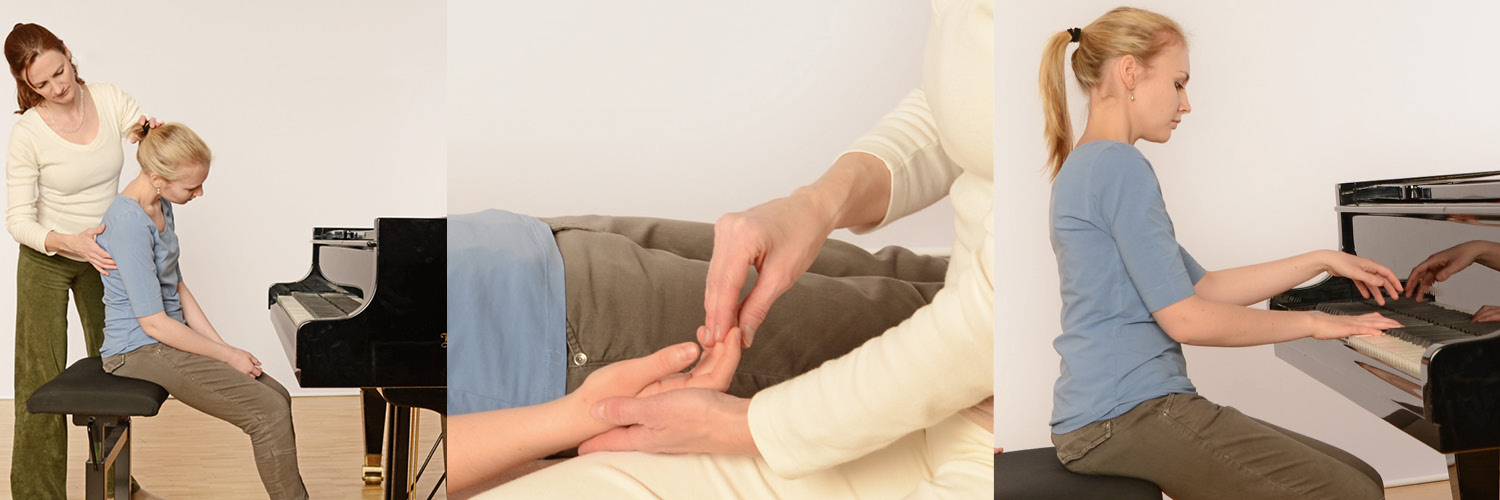The Feldenkrais Method for Musicians
The Feldenkrais Method is named after the nuclear physicist, engineer and judo master Dr. Moshé Feldenkrais. He developed this method through decades of research in the fields of anatomy, physiology, neurology, developmental psychology, physics, mechanics and cybernetics.
Instrument – Body – Voice
Making music places high demands on the body, its flexibility, its coordination with the instrument or for singing, and on the minute precision necessary for controlling and differentiating movements – just one millimetre or millisecond can make a huge difference. The more economically a movement is distributed throughout the body and the clearer its direction, the better the musical result, the better the health of our movement apparatus, and – of course – the better our overall wellbeing and confidence.
Fundamental for free, nuanced, joyful and easy music-making on a high level are both an alert awareness of the body, and the optimised use of the entire body in connection with instrument and voice. The decisive factor here is the interaction between movement and perception. Frequently, our mental image of what we think we are doing differs considerably from what we are actually doing. The more acute our awareness for the way we are doing something, the more precisely we can adapt our actions to achieve the musical result we want.
The Method
The Feldenkrais Method focuses on the only place from which patterns of movement and posture can be altered in a sustainable fashion: it works with the motoric part of the cerebral cortex. It is from here that commands are sent out to the muscular system. Work on the body, via the skeletal system and the muscles, serves as a medium of communication with the central nervous system. Consequently, very small, gentle movements are sufficient for bringing about effective changes, since the method exploits the nature of our nervous system and its organisation. This includes the brain’s extraordinary capacity for learning throughout our entire lives, and striving towards the optimal organisation of the body in relation to its environment – the use of gravity, for example.
New Organisation of Movement Sequences
The directions for movement, and the way the individual one-to-one sessions are conducted, are designed to provide the nervous system with as much, as fine and as differentiated information as possible, so that it can re-order and adjust itself alone. Habitual movements are performed in new, unfamiliar contexts, and thus are experienced both consciously and in new ways. This enables us to recognise more easily tensions that inhibit freedom of movement, and to discover alternative, easier versions of the movement. In a nutshell, it is about learning, re-learning and further self-development. Suddenly, subtleties and variations of a previously unimaginable quality appear in our movements and are appreciated consciously, opening the door to further possibilities.
Easy, efficient and flowing movements are related to the quality of our effort, i.e. the dosage and coordination of strength distribution, and how directly the exerted effort goes where it should do.
Group Sessions
In group sessions, known as “Awareness Through Movement”, I use verbal instructions to lead participants through specially structured sequences of gentle movements in lying, sitting or standing positions. These sequences are dedicated to fundamental themes of movement organisation, and also take into account musicians and the particular challenges of their instrument or voice usage. Perception, consciousness and understanding for one’s own movement processes and habits are heightened and brought into focus through directing the awareness to specific areas and gradually exploring the interrelations between our movements. Participants come to experience the efficient use of the skeleton and gravity, and are given the tools necessary for recognising and releasing inhibitive tensions, leading to the discovery of easier and variegated movement and postural possibilities – including with the instrument and voice.
In this way, the ability to deploy and control movements can be significantly improved, leading to more effective, economic, easier movement and improved general wellbeing. Through the playful discovery of our own diversity of movement, we become aware that we are, in fact, able to change things, rather than struggling against insurmountable obstacles. Ease of movement, strength and wellbeing are the consequence of using the body in a way that is appropriate for oneself.
One-to-One
In one-to-one sessions, known as “Functional Integration”, I cater for your own personal needs. You become aware of your body primarily through hands-on work: I move your body for you. Through diverse movements, which activate neurological and developmental-related functions as well as familiar and instrument/voice-specific movement and postural patterns, you are made aware of patterns of tension and possible alternatives. The nervous system is given the opportunity to reorganise itself more appropriately. In a gentle and supportive way, less flexible areas of the body – such as the neck, lower back, shoulder blades etc. – are integrated into the overall movement once more. Using these techniques, it is possible to neutralise muscular imbalances, recalibrate misalignments in the spine or joints, relieve the symptoms of overuse – which always result from the overall organisation of the body – and reveal your own potential for movement. To complement this treatment, you can continue the process at home with exercises tailored to your individual needs.
